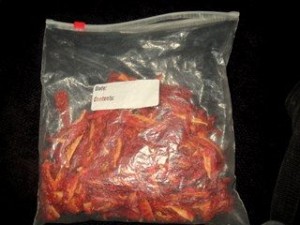Author: Heather Hacking hhacking@chicoer.com @HeatherHacking on Twitter
As much as I may secretly wish it, I will never be one of those crafty, home-spun, easy-bake, savory-leftover type of women.
At this age I also doubt that I will discover the equivalent of penicillin, fly to a distant planet or meet anyone particularly famous unless I happen to be in a public bathroom at the right time.
Most of the time I’m fairly happy, so if I’m mediocre I can live with that.

However, this region has so much food lying around in summer I wish I was more skilled at food preservation.
People often offer me their garden excess. I always say yes and sometimes even make shameless pleas to glean other people’s trees.
Yet, the beauty of bounty wanes when you botch the batch.
Cold/dry storage
Unless there is a power outage, freezing fruit is a no-brainer.
Last year I had unlimited access to peaches, plums and blackberries. Now, a year later, I occasionally dislodge a bag of plums when I’m stashing the frozen yogurt.
The next easiest way to prepare extra food is to fill up the food dehydrator.
The problem is, once you have stored dehydrated fruit, you need to eat it.
My boyfriend will sit and nibble peaches when he has nothing better to do. But I’m more of a chocolate go-to girl.
Salads make great catch-alls for food that took great effort to preserve. I use kitchen scissors to hide small pieces of plums or figs among the other foliage.
This week I remembered the fruit when I was making a mystery meal.
Two bags of quinoa are competing for room in my freezer. Two family members bought big bags of the grain, then realized they ate it infrequently.
As I mixed up my quinoa concoction, I fantasized about making something so odd and wonderful that people at potlucks would praise my name.
Mix and match
Instructions for mystery quinoa goulash:
Add appropriate amount of quinoa and water to rice cooker. Look through cupboard for dried and forgotten food. Look in fridge for leftovers that will soon be compost.
Dried foods can be added directly to the water in the rice cooker. I found dried figs (which were fantabulous), dried tomatoes and whole almonds (not sliced). I also diced up a tomato and about a quarter of an onion.
At the end, cold grapes were cut in half and dumped on top.
When you perfect this recipe, let me know. My dish was only so-so.
Reality of math
You really can’t get enough “sun-dried” tomatoes, which I like to call “fruit Skittles.”
When tomatoes went on sale for $1 a pound, we bought nine measured pounds of romas, and sliced each fruit into six long slices.
Once filled, the food dehydrator was placed on the back porch, so the house would not heat up.
Through experience, I learned the batch dries in about 14 hours.
The next day I worked late and called my boyfriend to protect my investment. Could he check the tomatoes in two hours?
It was a simple request. He’s an adult.
Apparently, I will be buying him a wrist-watch with an alarm this Christmas.
Luckily, I have learned that even crispy-dried fruit will soften when added to a rice cooker with quinoa.
The big question is, if it cost $9 to buy the tomatoes, and perhaps $1-2 to run the machinery, would I have been better off buying a big bag of dried tomatoes at the warehouse store?
The solution, of course, is to beg my friend Holly for a big box of free tomatoes.
